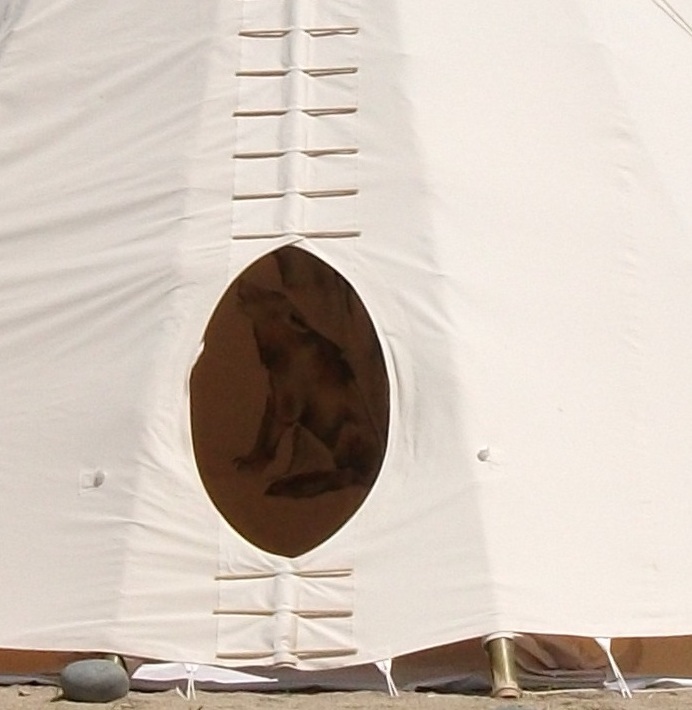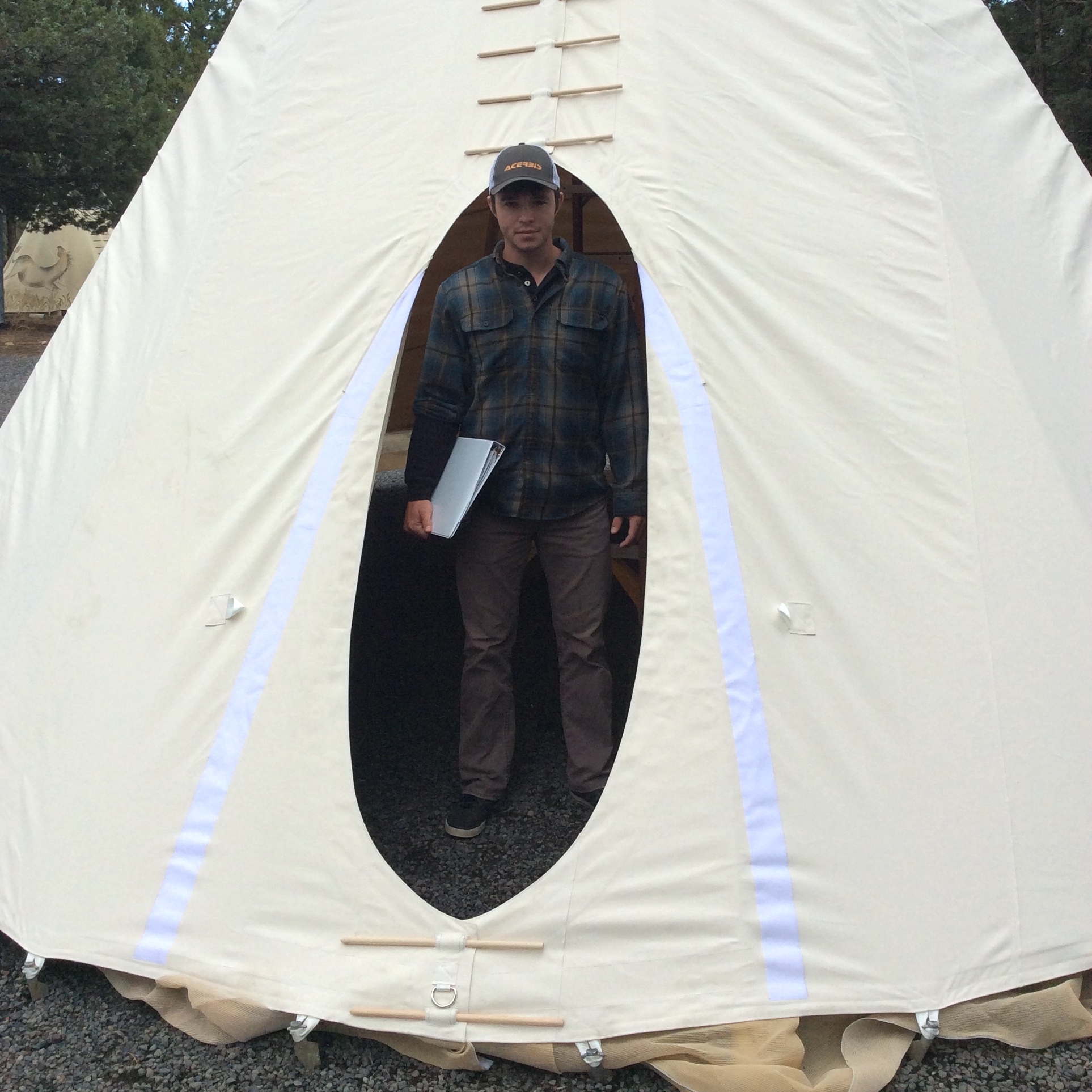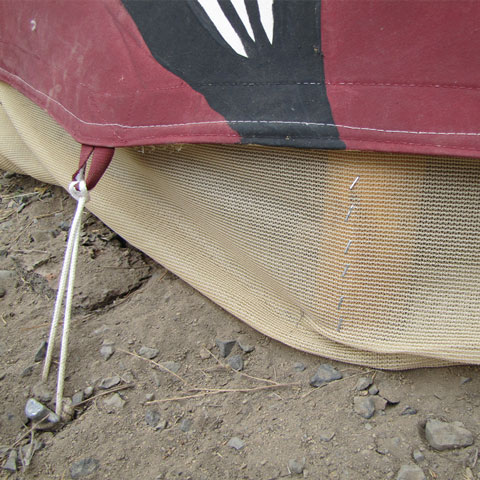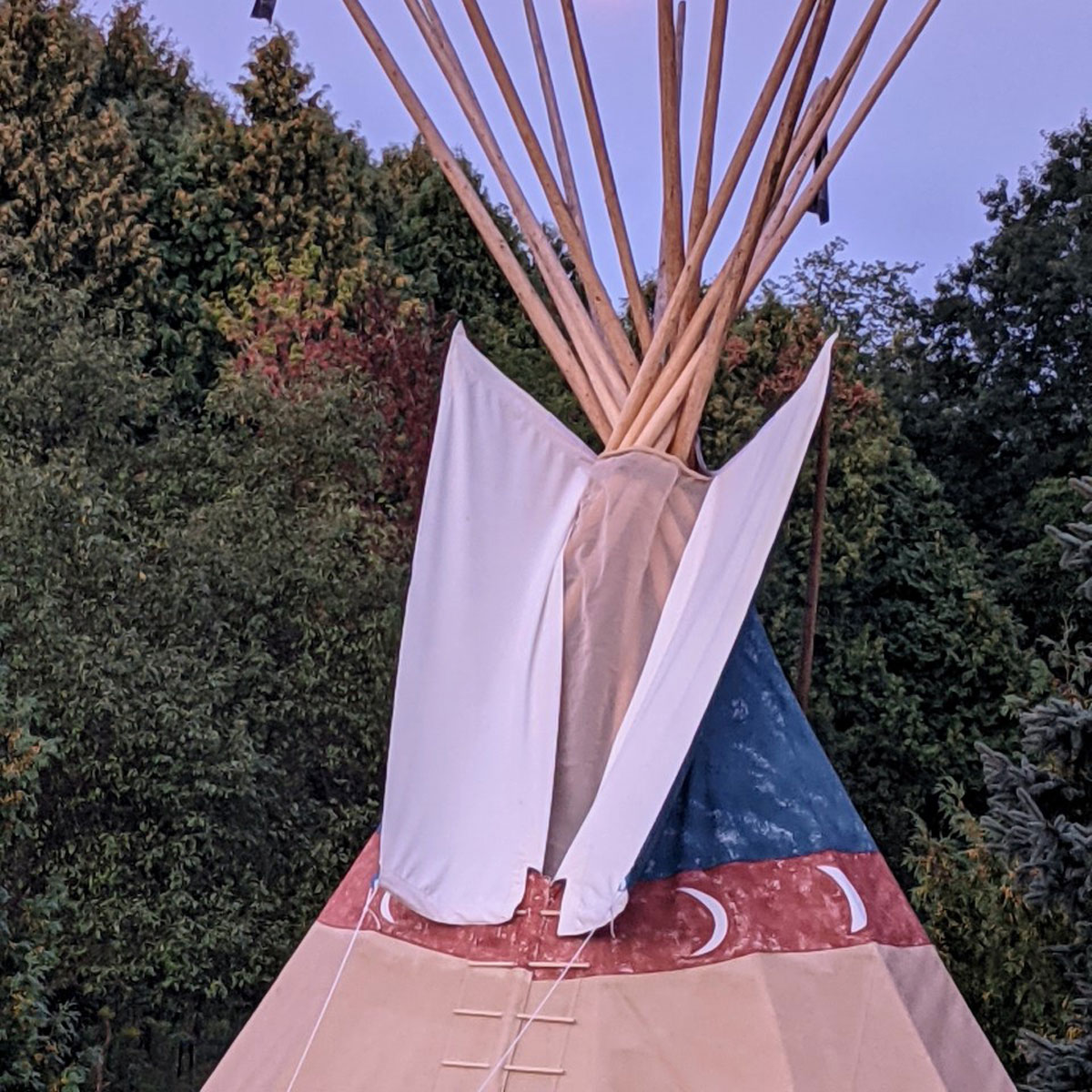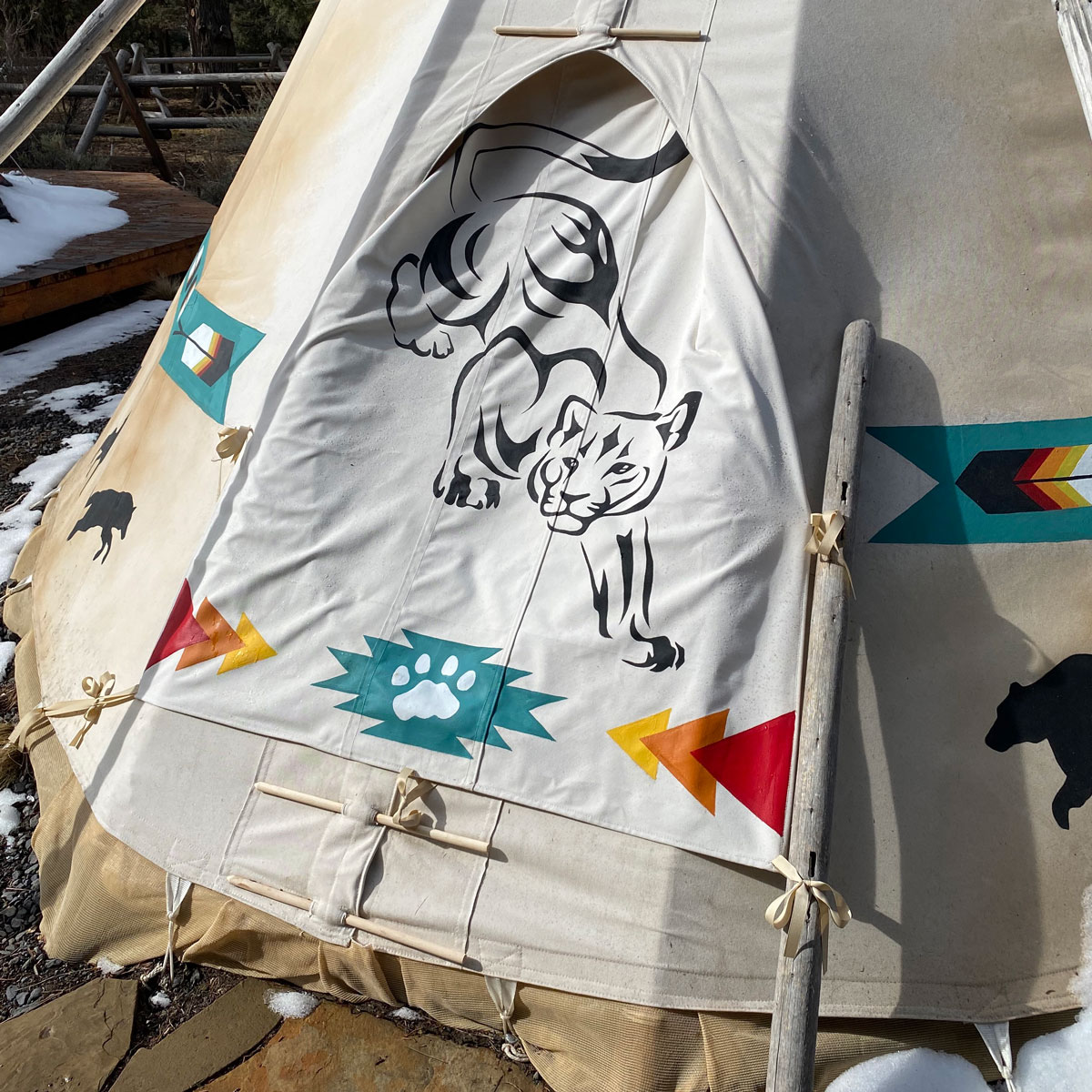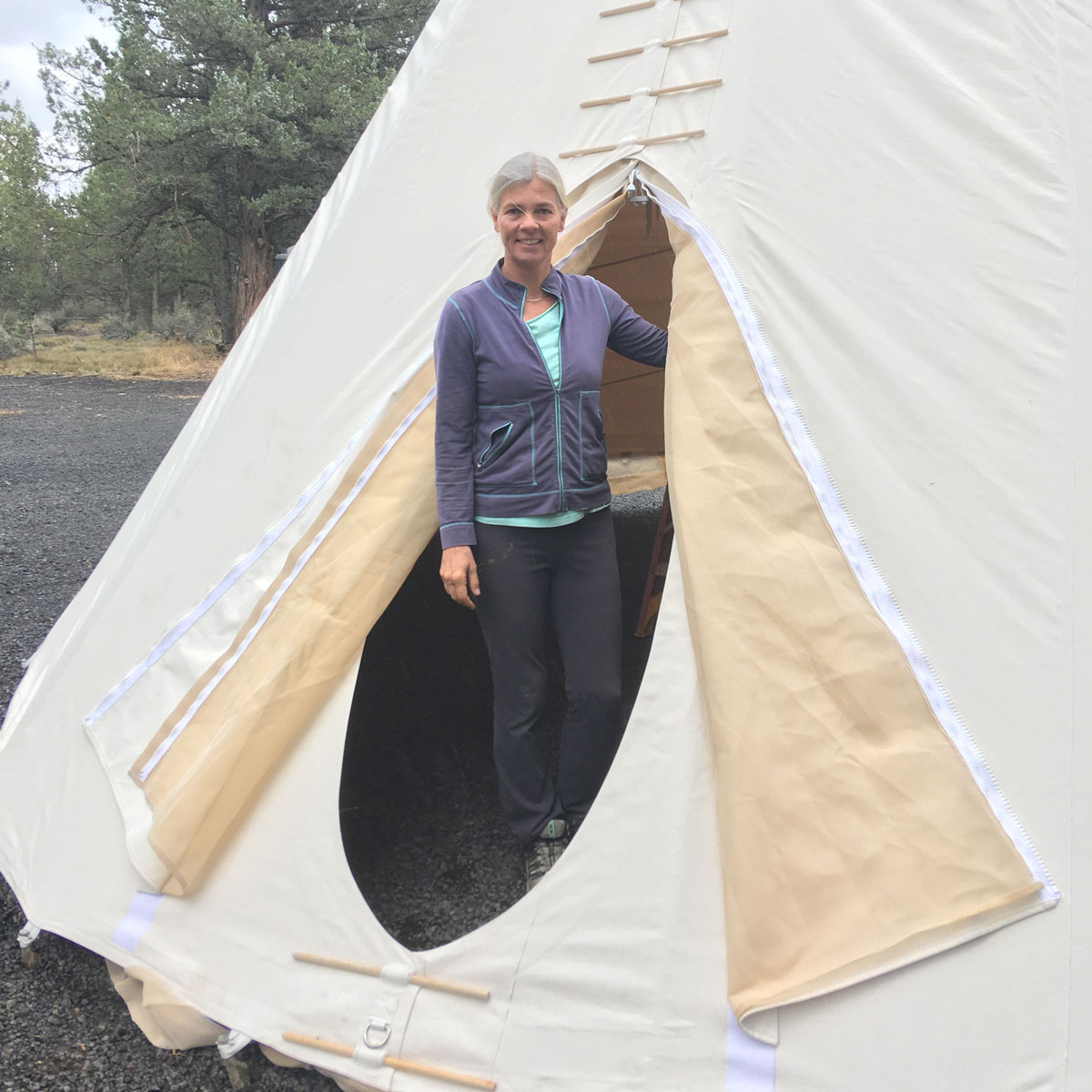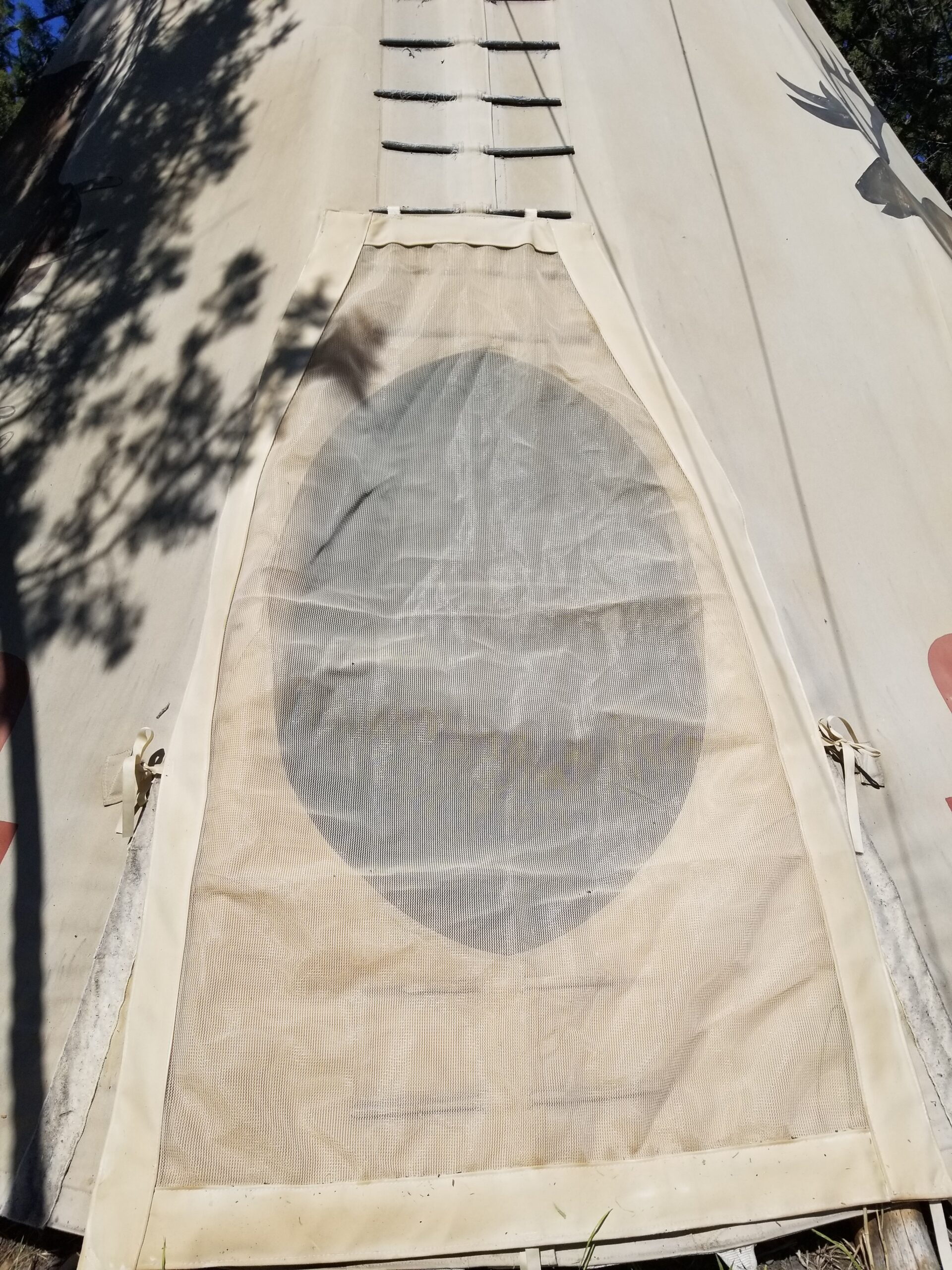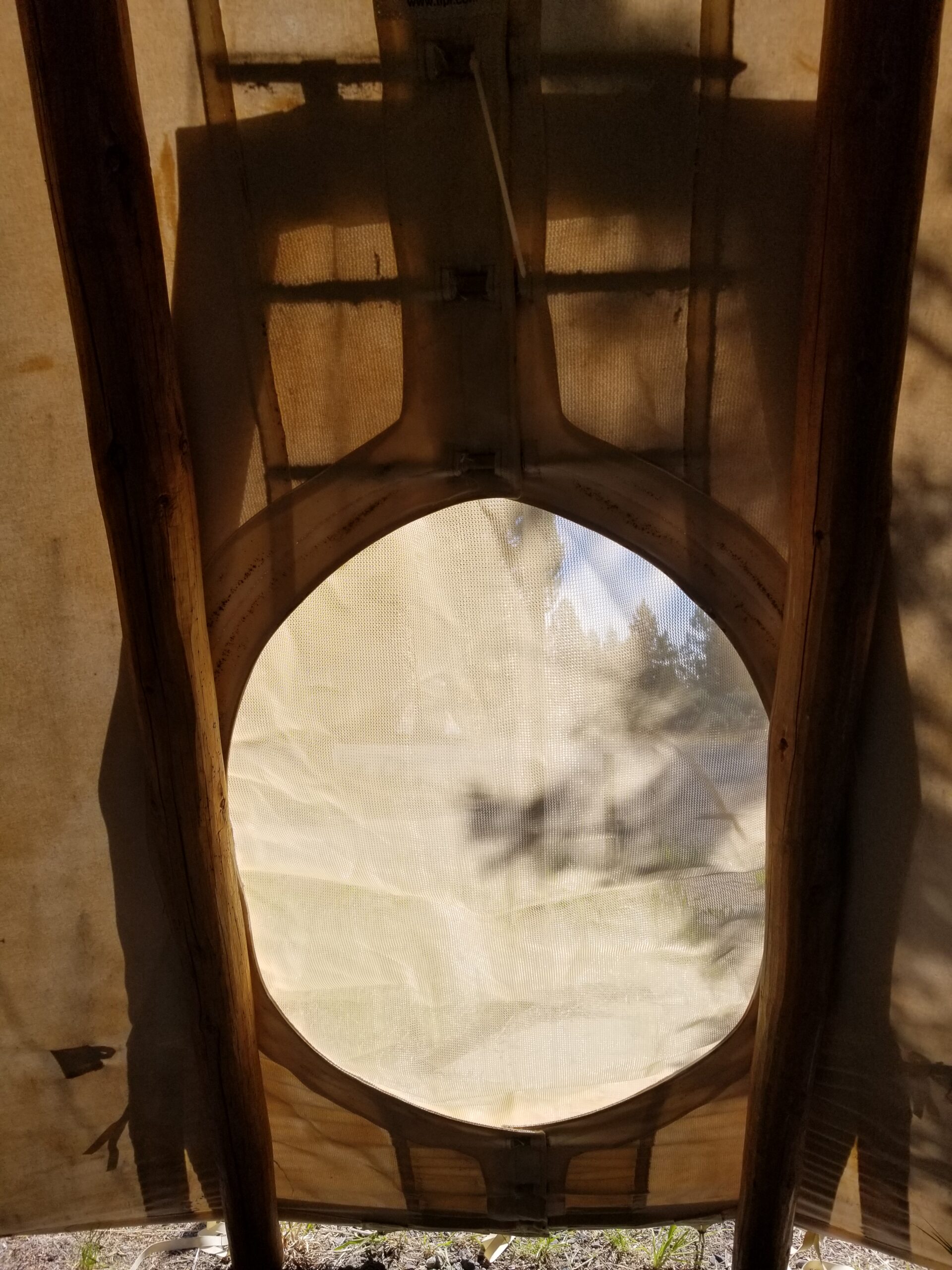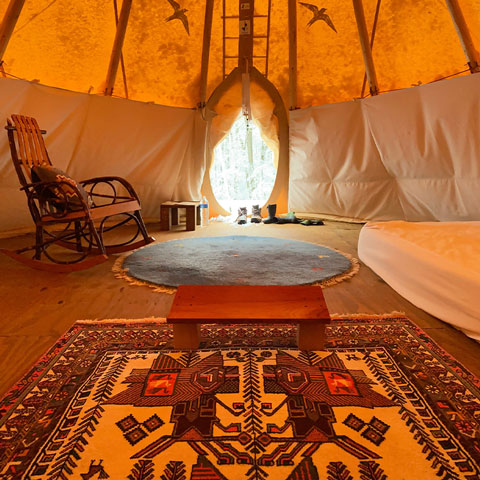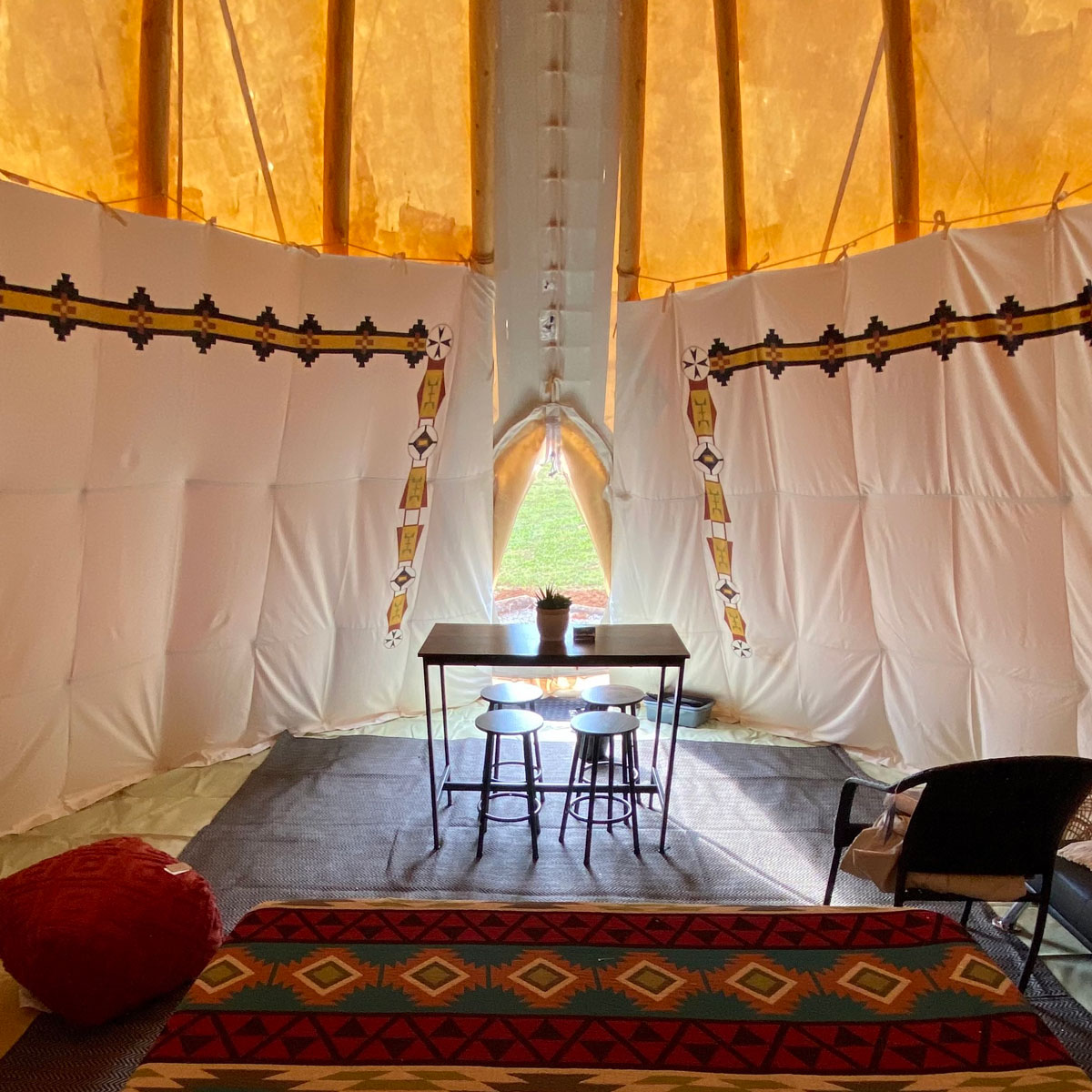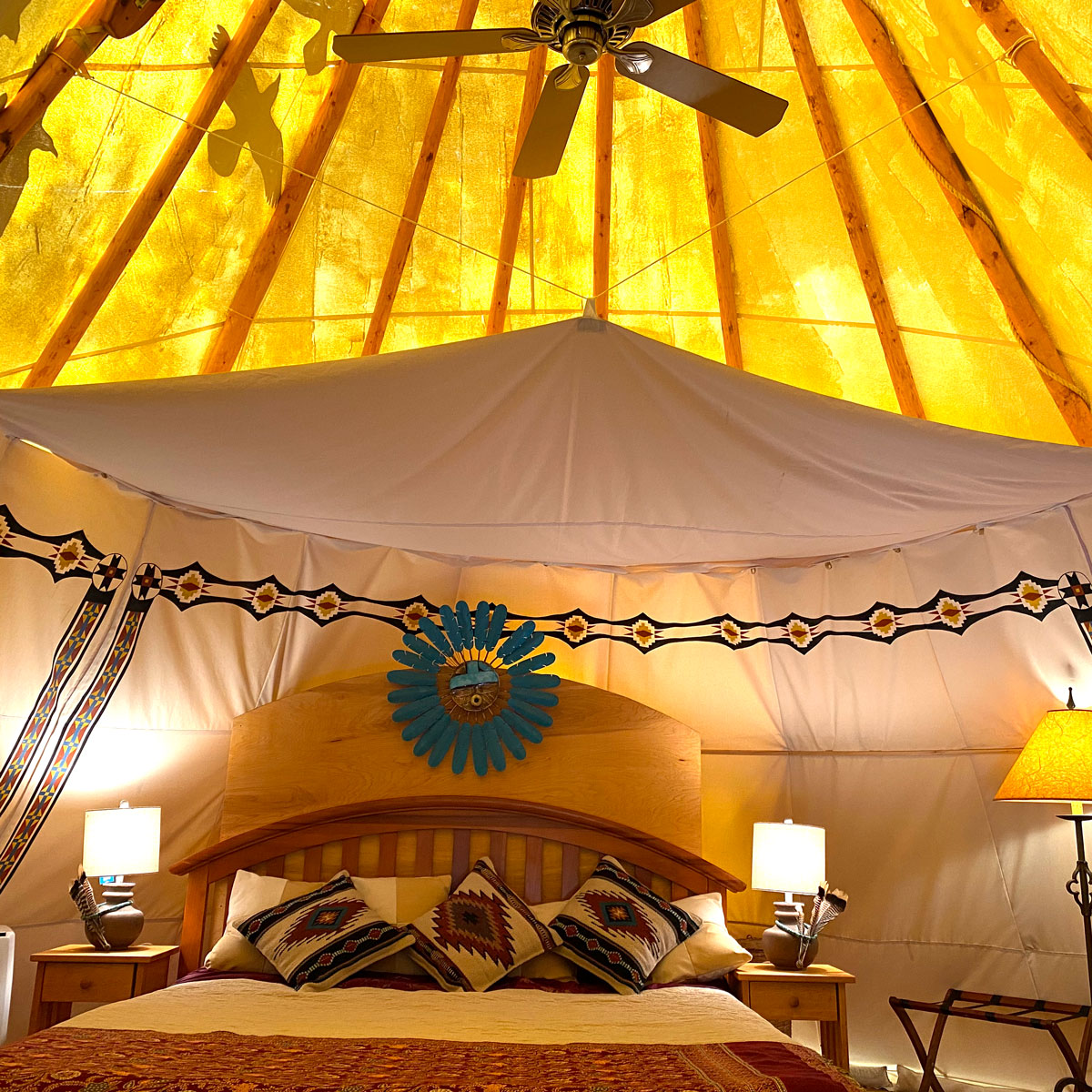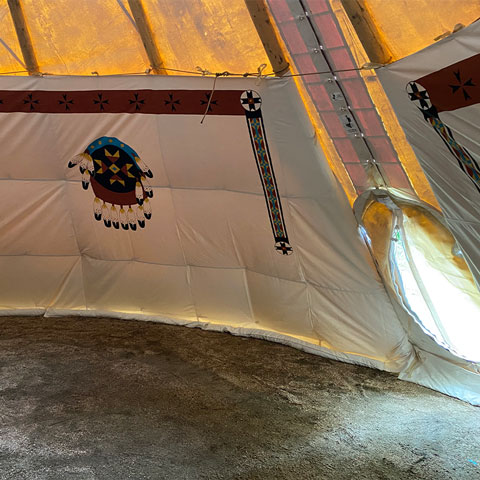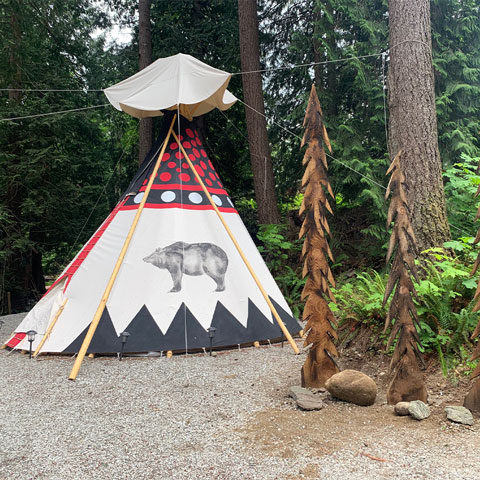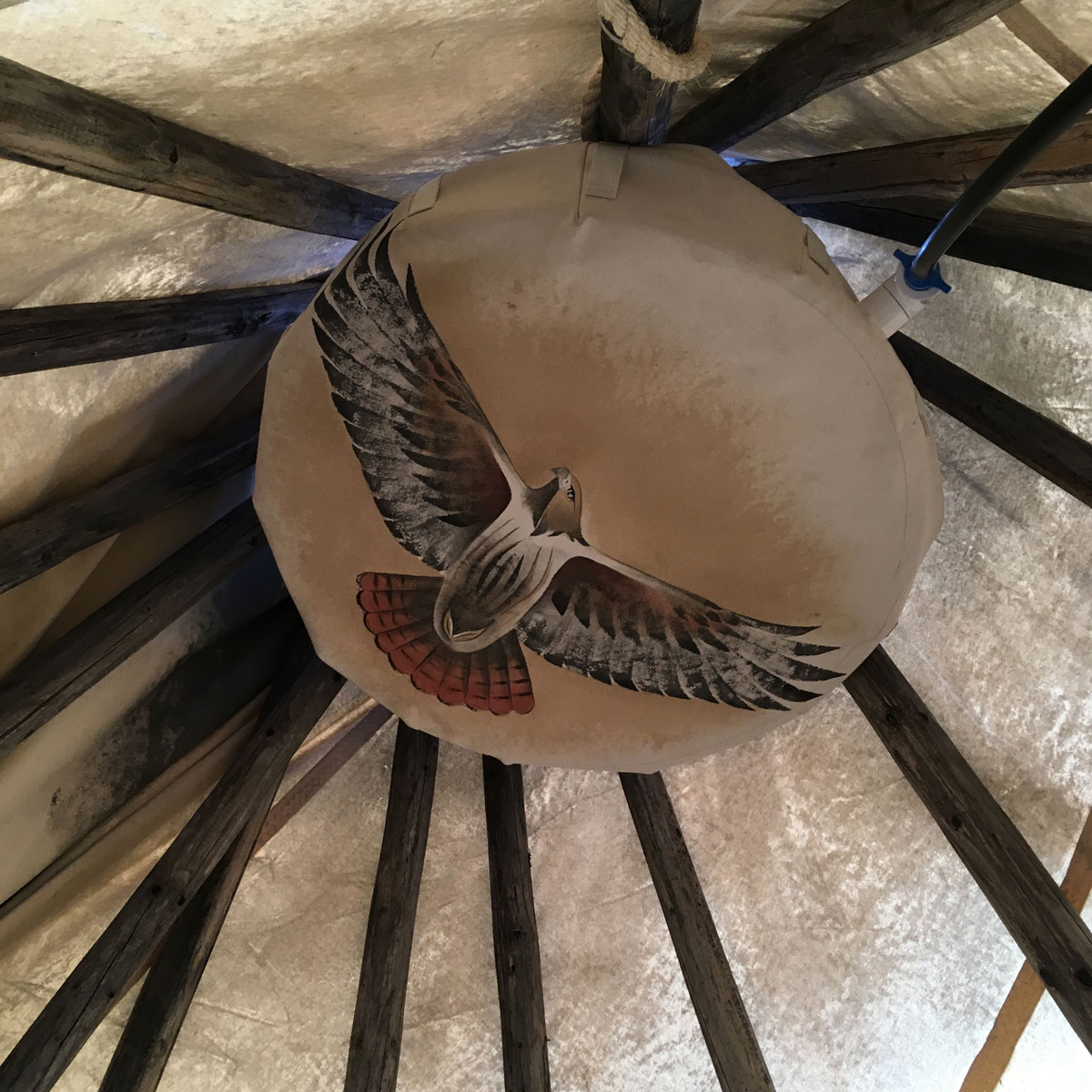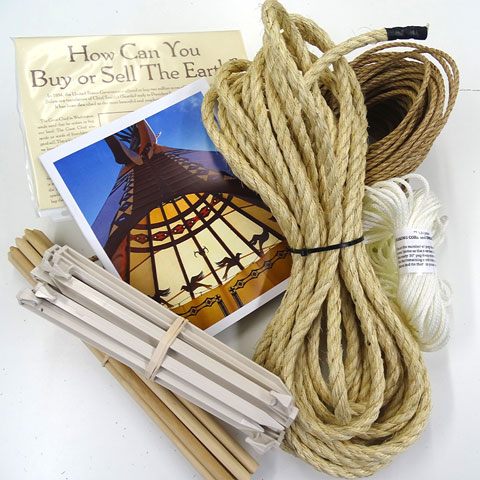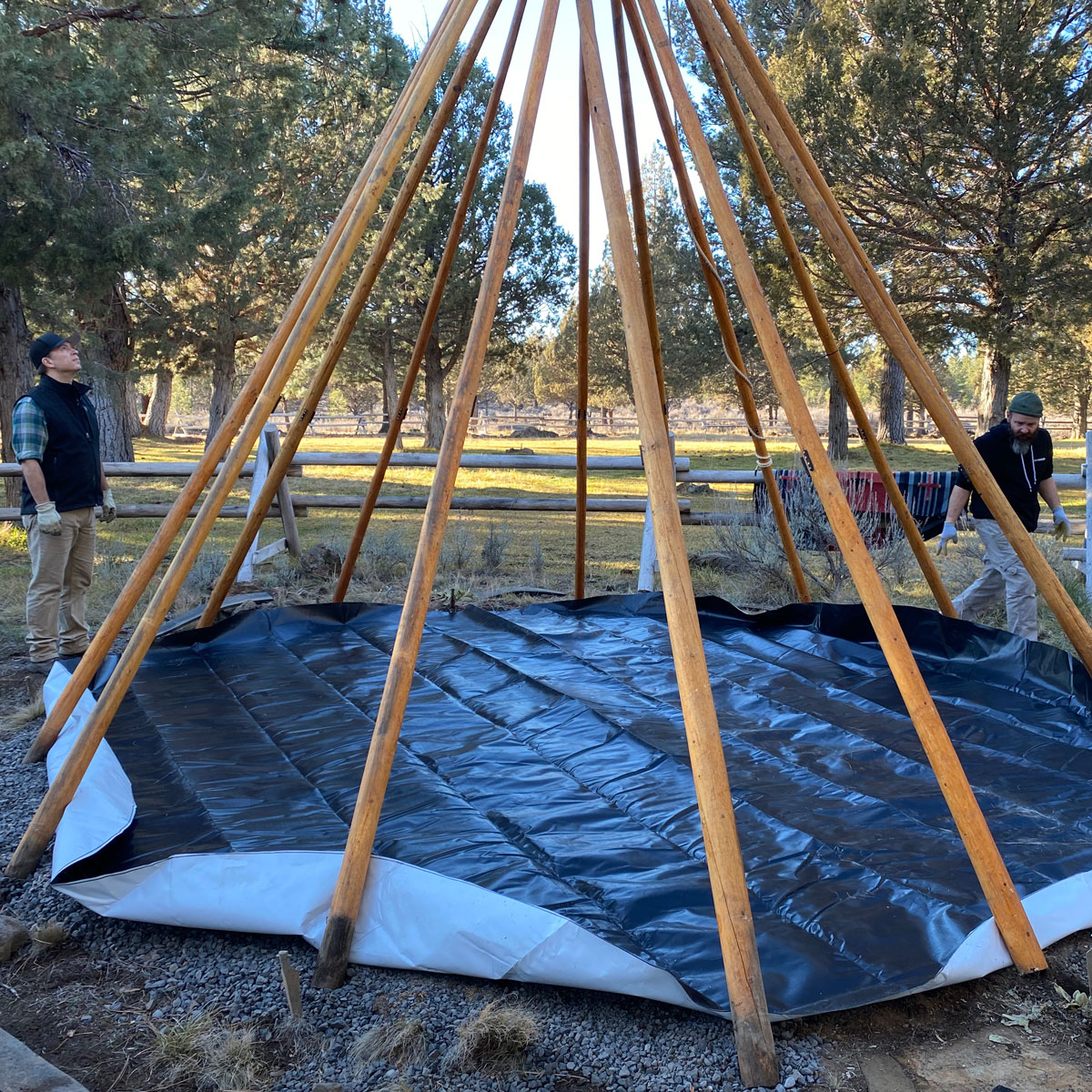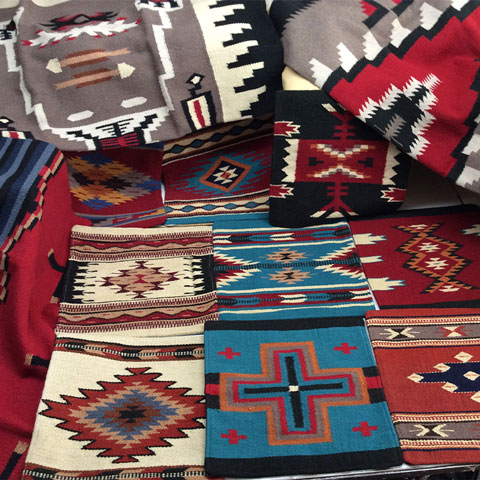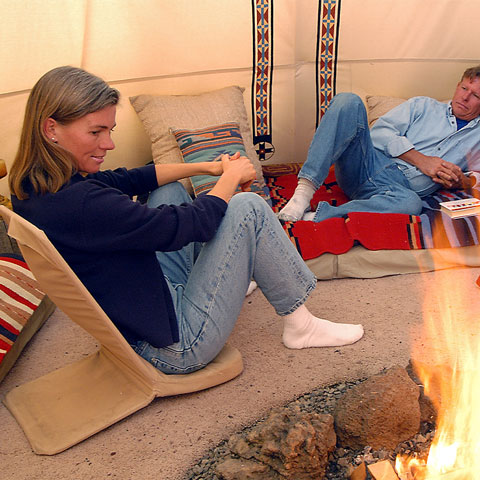TEEPEE COMPONENTS

A component is an individual item that can be purchased and a combination of components are necessary in order to set up a tipi. These are covers, liners, doors, poles and accessories. We also offer components that are not essential, but that make living in a tipi more comfortable.
COVERS
TRADITIONAL & CAMPGROUND
Traditional cover with opening for Door Flaps
Campground cover with opening for Zipper Doors
The Traditional Model tipi cover has a standard 3’9” door opening with a vertical height of 4 ft. from the ground. It is held together with three lacing pins at the bottom of the door opening and, depending on the size of the tipi, a varying number of pins above the door opening. The door opening is covered with a door flap.
The Campground Model tipi cover for the sizes 12 ft. to 18 ft. has a 4’7” door opening with a vertical height of 4’2”. For the sizes 20 ft. – 26 ft., the door opening is 6 ft. long with a vertical height of 5’ 9”. It is held together with two pins at the bottom, which makes the step over at the bottom edge of the door opening easier. The Campground tipi cover has 3” wide velcro strips on both sides of the door outside as well as on the upper part inside. This is the attachment for the Zipper / Mosquito Screen Door, which gets attached after the tipi cover is pinned together. Heavy duty D-rings outside and a red loop tape inside can be used to lock the zipper door.

CRITTER GUARD / MOSQUITO GUARD
Critter Guard
Mosquito Guard
We are using the same tan colored, tightly woven polyester mesh for our Critter Guard, Mosquito Guard and the secondary Mosquito Screen Door. The Critter Guard is sewn onto the bottom reinforcement of the tipi cover. This allows it to stretch outwards and beneath the poles, so the poles can sit on it and create a tight fit with the ground. We do recommend weighing down the critter guard in between poles, so critters do not crawl underneath it.
The Mosquito Guard is sewn onto the right smoke flap seam. It has three long ribbons on its opposite side, which help wedge the mosquito guard in between poles and tipi cover. It effectively covers most of the smoke flap opening and prevents birds and most mosquitos from flying into your tipi.

DOORS
TRADITIONAL & CAMPGROUND
Door Flap for Traditional Models
Zipper Door for Campground Covers
Our Door Flap is a door covering that is tied to the 5th pin as well as to the door pole and the #1 pole on the inside of the tipi. The door flap is trapezoid in shape and widens once it gets flared outwards and rests on the outside of the tipi cover, where it can be tied to the outside loops. To create a door handle and to give the door flap more stability, you can tie a wooden stick or a thin log on one side. You may also choose to tie two logs to the door cover, one on each side. Let us know if you would like to add an extra pole to your order, which you can cut up for this purpose.
Our Zipper / Mosquito Screen Door is the door style for the Campground Model. It is our own design which we engineered and patented -US Design Patent NO: US D948,748 S. It grew out of the need for a larger and sturdier door solution that provides easier access, that has a privacy screen while protecting against bugs, and that can be locked. The zipper door is attached to the campground cover with 3” wide velcro bands. This way, the zipper door is securely fastened to the outside and inside of the tipi cover, once it is pinned together. The zipper door can also be purchased without the additional secondary mosquito screen door.

TRADITIONAL SUMMER SCREEN DOOR FLAP
Summer Screen Door Flap for Traditional Models
Inside view of Summer Screen Door Flap
Our Summer Screen Door Flap gives more light and fresh air circulation, without letting in all the bugs. It is a canvas wrapped mesh door made using the same durable material as our Critter and Mosquito guard. The Summer Screen Door Flap is outside mounted and tied to the 5th pin, as well as the door loops on each side of door hole. One side can be tied to a door pole, like a Traditional Door Flap, for easier opening.

TEEPEE LINERS
6 FT. & 9 FT
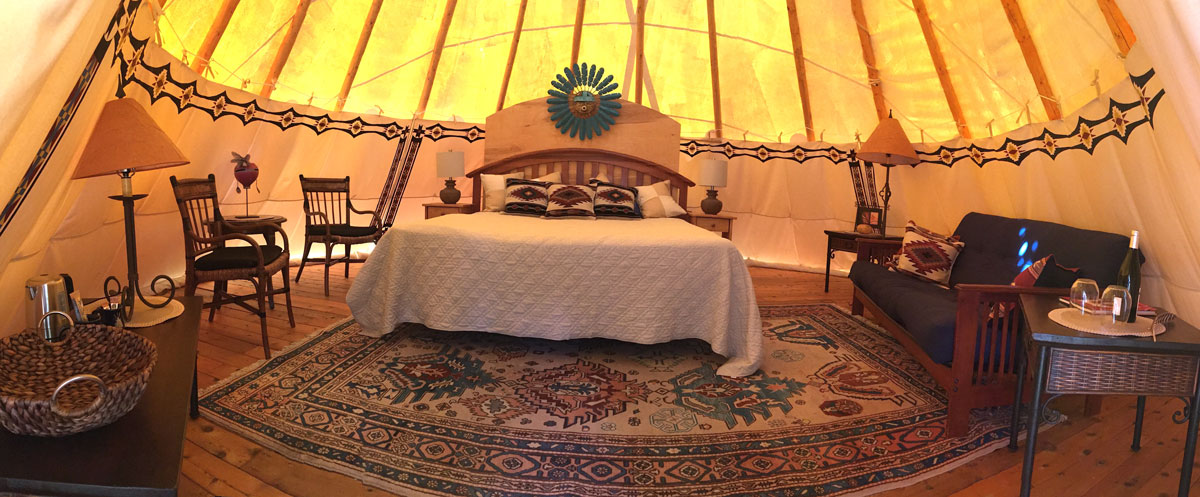
6 ft. Liner in a 24 ft. tipi. Vertical liner stripes mark the 3 sections
All our Liners come in three sections which are velcroed together with a continuous 1” velcro strip, a feature unique to a Nomadics liner. The velcro assures that the liner sections do not move apart and leave a gap in between them, which would allow cold air to flow through.
Liners are offered as 6 ft. Liner and 9 ft. Liner, although this is not their vertical height. The vertical height of a 6 ft. liner is 5’6”, the vertical height of a 9 ft. liner is 8”3”. We recommend a 6 ft. liner for tipis up to 18 ft. diameter, and a 9 ft. liner for the larger 20 ft. – 26 ft. sizes or for additional insulation in the winter. The main function of the tipi liner is to insulate the tipi for warmth and to create an updraft of air between the tipi liner and tipi cover for air circulation.
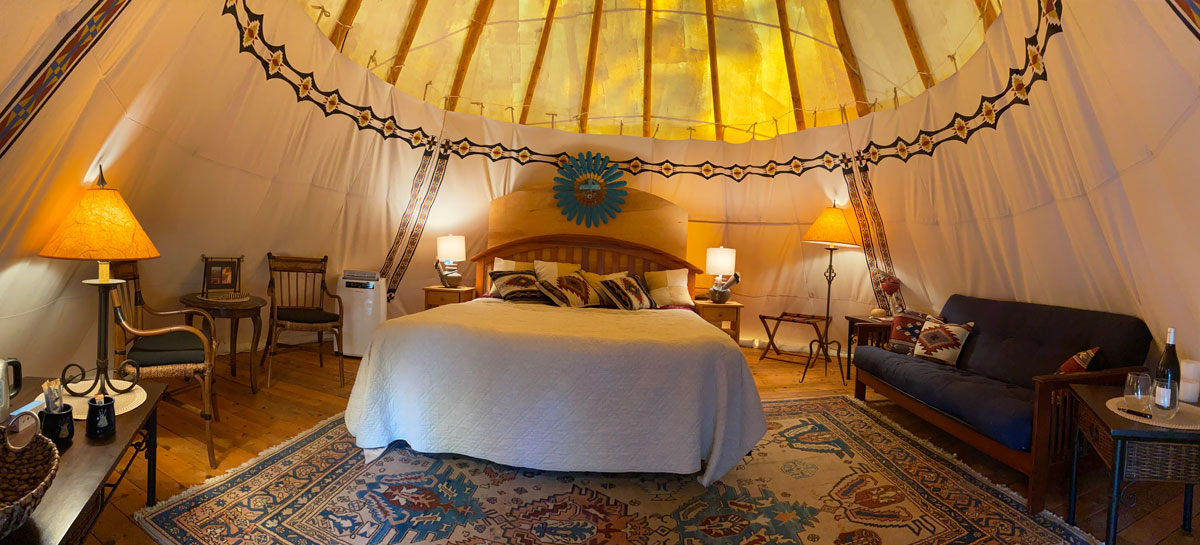
9 ft. Liner in a 24 ft. tipi. The extra height provides privacy and insulation
6 ft. Liner
9 ft. Liner
This gentle flow of air will help move the smoke out of the tipi on windless nights. A liner is absolutely necessary for insulation if you are living through the winter, and it can be combined with an ozan for extra heat retention. Another function of the liner is to provide privacy, as shadows can be seen on the tipi cover at night. Our liners have some extra length at the door, which can be tucked around the door poles. Each liner has a 6” lip at the bottom that tucks forward and needs to be weighted down, so that it creates a snug fit with the floor. You may use wooden logs, bricks, tiles or stones, or use our sand snakes in combination with the door snake.

OZAN
If you are planning on living through the winter in a cold climate you may want to consider putting an Ozan inside your tipi. An ozan is an interior awning that extends from the top of the tipi liner forward into the tipi. A 6″ flap of fabric drapes over the backside of the liner to make a seal where the ozan meets the top of the tipi liner. For a snug fit, you will need to cut the fabric 6” deep at the exact location of each pole, so the fabric can drape around them.
LINER & DOOR SNAKES
Our Sand Snakes are 6 ft. long canvas tubes that you would need to fill with sand or gravel. They have a 1” velcro closure and weigh about 30 lbs once they are filled. Their purpose is to weigh down the liner so no air or little critters come through on the bottom.
The Door Snake is our own invention and construction. It is 3 ft. long and fills the space between the two poles at the door. As there is no liner beneath the door opening, we have added a flap that will cover the entire opening beneath the door. The flap for the traditional model has ties, which can be tied to the 3rd pin and the poles. The door snake flap for the campground model has a velcro band that can be attached to the cover.

RAIN CAP – EXTERIOR
The tipi originated with the plains cultures of the vast, open, dry grasslands of the Great Plains area. If you are planning to use your tipi in consistently wet climates for extended periods of time, you may want to consider using an Exterior Rain Cap. Jeb first saw a small historical book written by Ernest Thompson Seton, who later founded the Boy Scouts of America. Seton had drawn a sketch of what he called a “Missouri Rain Cap” when he first saw it while living with the Missouri Indians.
The rain cap is a 9 ft. or 12 ft. round fabric circle with 8 loops. We also provide rope and stakes to tie it to nearby trees or to stake it to the ground. CAUTION: Do not secure your rain cap to the peg loops of the teepee cover, as you are tying a potential parachute to your tipi. If wind gets underneath the rain cap and lifts it up, it could potentially lift up your cover as well, which will cause the whole tipi to collapse.
RAIN CATCHER – INTERIOR
The Interior Rain Catcher consists of a 28” diameter plastic water heater drip pan that sits inside a canvas pan of the same size. The drip pan has a drip spout, where you connect a clear plastic tube that guides the collected rain water down a pole, behind the liner and out of the tipi. We estimate it eliminates about 80% of the raindrops that come into the tipi, but it does not work well when torrential rains are expected.
The canvas pan is painted with a beautiful red tailed hawk and serves as a mounting aid to the actual plastic pan. You will need a ladder to attach the velcro drip spouts to the poles and hook the rain catcher to the cover rope. It is best to mount this before the tipi cover is wrapped around the poles.

SET-UP ACCESSORIES
Our Set-Up Accessories consist of a ½” sisal cover rope, synthetic liner rope, wooden lacing pins, 1 ft. plastic stakes and enough synthetic rope to cut your 30” long staking cords and 2 smoke flap cords out of it. We also provide a detailed set-up instruction booklet and two small posters with quotes from Chief Seattle and Sitting Bull. Depending on supplies, we often add a gift of a smudge stick, made by our Native American friends.
GROUND FLOOR
Our Ground Floors are made of sturdy polyethylene tarp in black on one side, white on the other side. Several lengths are welded together and cut into a circle of the same diameter as your tipi. A utility knife or scissors is all you need to cut it in shape or cut out a space for your fire pit. We see this floor solution as a moisture barrier, not as a final floor. We recommend that you add carpet padding and carpet on top of it, to create a cozy interior.


